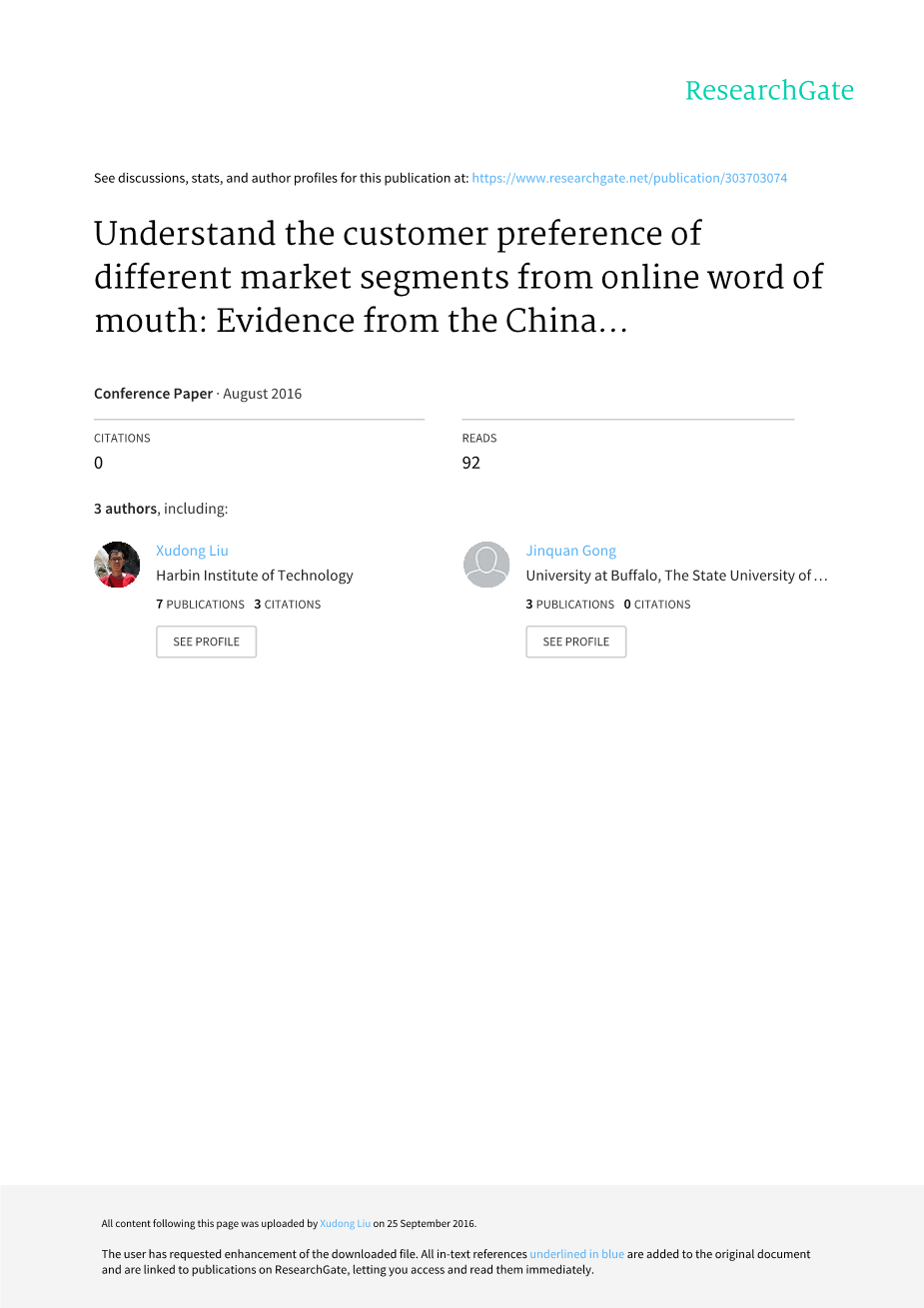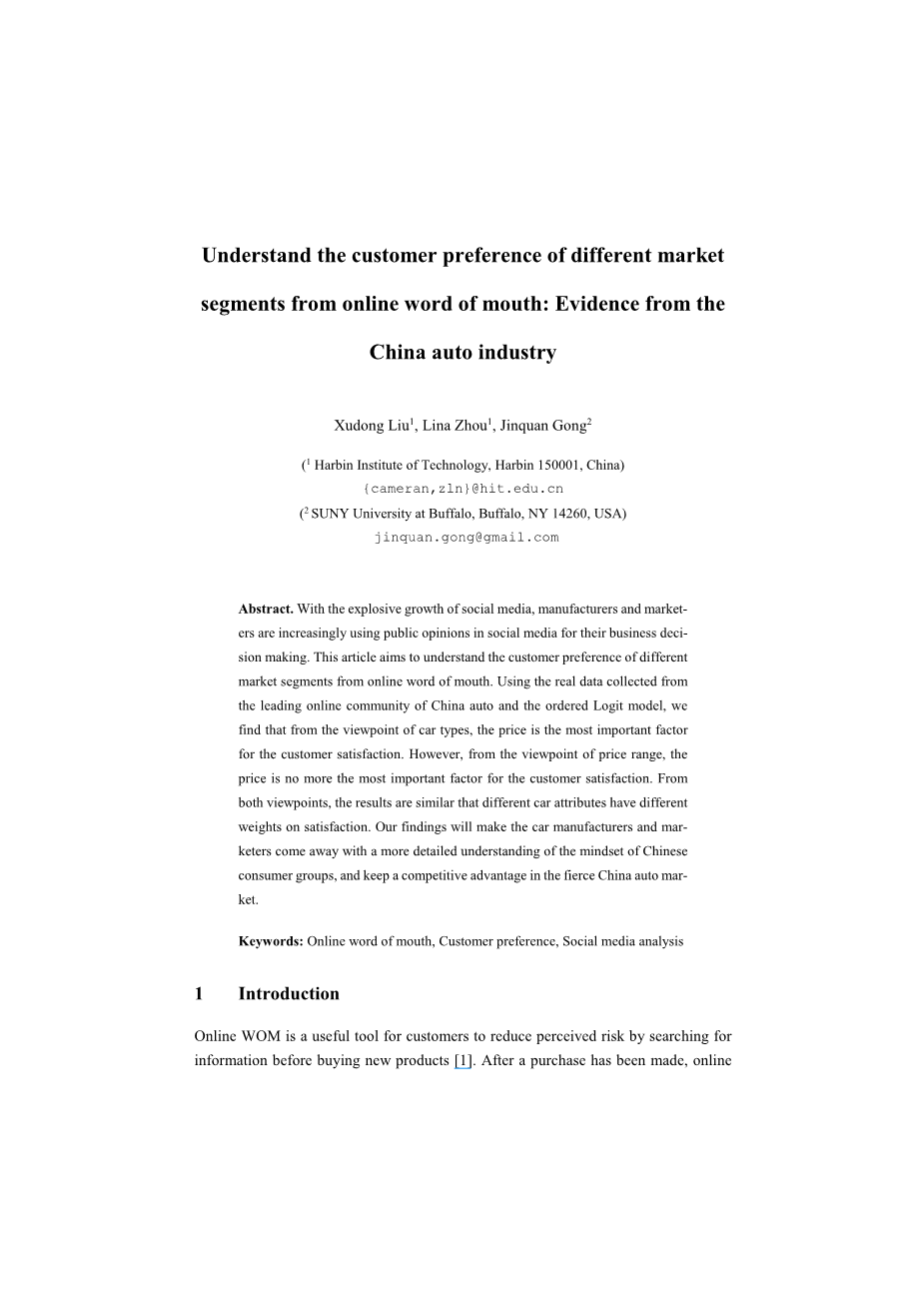

英语原文共 15 页,剩余内容已隐藏,支付完成后下载完整资料
原文
Understand the customer preference of different market segments from online word of mouth: Evidence from the China auto industry
Xudong Liu1, Lina Zhou1, Jinquan Gong2
1 Harbin Institute of Technology, Harbin 150001, China
2 SUNY University at Buffalo, Buffalo, NY 14260, USA
Abstract
With the explosive growth of social media, manufacturers and marketers are increasingly using public opinions in social media for their business decision making. This article aims to understand the customer preference of different market segments from online word of mouth. Using the real data collected from the leading online community of China auto and the ordered Logit model, we find that from the viewpoint of car types, the price is the most important factor for the customer satisfaction. However, from the viewpoint of price range, the price is no more the most important factor for the customer satisfaction. From both viewpoints, the results are similar that different car attributes have different weights on satisfaction. Our findings will make the car manufacturers and marketers come away with a more detailed understanding of the mindset of Chinese consumer groups, and keep a competitive advantage in the fierce China auto market.
Keywords: Online word of mouth, Customer preference, Social media analysis
1. Introduction
Online WOM is a useful tool for customers to reduce perceived risk by searching for information before buying new products [1]. After a purchase has been made, online WOM offers an easy and convenient way for consumers to comment on their acquisitions, complain about their dissatisfaction, share details with friends, or even argue with vendors [2]. Researches have shown that WOM communication is more influential than communications through other sources such as editorial recommendations or advertisements, because it is perceived to provide comparatively reliable information [3]. A survey on Wall Street Journal also showed that 71% of online U.S. adults use online consumer reviews for their purchases and 42% of them trust such a source [4].
Online WOM is also useful for marketers and manufacturers. On one hand, online WOM has been regarded as a positive and effective marketing tool through which to execute business strategies [5]. For example, some businesses regularly post product information online and sponsor promotional events in online communities [6], or even manipulate online reviews strategically to influence purchase decisions [7]. On the other hand, online WOM is useful for the manufacturers and marketers to understand the customersrsquo; requirement. For example, manufacturers can use online WOM to decide to create new models or redesign existing models [8]. Manufacturers and marketers can derive the pricing power of product features [9], or estimate the aggregated customer preferences [10] to decide on which product attributes to promote and highlight in online or offline advertisements.
China has overtaken the US to become the largest car market in the world from 2009 [11], however the personal car ownership in China still remains low. According to CAAM [12], the car ownership rate is 105.83 cars per thousand people in the end of year 2014. The rapid growth makes the online automobile communities very popular. For example, Autohome, the leading China online automobile community, reports more than 17 million unique visitors per day [13]. Autohome provides a sophisticated online WOM column for the car buyers to share their experience of the car buying and usage. Using the China auto market as the setting for our study, we hope to address the question: How to infer the customersrsquo; preferences of the different car segments from online word of mouth? We believe the findings of our study will make the car manufacturers and marketers come away with a more detailed understanding of the mindset of Chinese consumer groups, and keep a competitive advantage in the fierce China auto market.
The rest of this paper is organized as follows. After briefly discussing the relationship between WOM and customer satisfaction, we propose the research hypotheses and build our empirical models. Using data collected from Autohome, we then present the statistical results and findings. The paper concludes with a review of the theoretical and managerial implications of our results, and a discussion of the limitations of this study and future research directions.
2. Relationship between customer satisfaction and WOM and hypothesis
Satisfaction is an outcome of purchase and use resulting from the buyers comparison of the rewards and costs of the purchase in relation to the anticipated consequences [14]. Customer satisfaction with a product or service has emerged as a key driver of WOM [15]. Anderson found the relationship between WOM and customer satisfaction has an asymmetric U-shape that extremely satisfied customers and extremely dissatisfied customers engage in greater word of mouth than the customers experiencing moderate levels of satisfaction [16]. Similar to Anderson, Hu et al. found the WOM have Jshaped distribution that people tend to write reviews only when they are either extremely satisfied or extremely unsatisfied, and people who feel the product is average might not be bothered to write a review [17]. obviously, the WOM implicates the satisfaction and preference of the customers.
Consumer behavior models typically suggest that (dis)satisfaction results from an evaluation of the rewards and sacrifices associated with the purchase [18]. Customers always need to balance many factors to make a satisfied purchase decision. In general, the price is believed to be the dominant determinant fa
剩余内容已隐藏,支付完成后下载完整资料
资料编号:[140107],资料为PDF文档或Word文档,PDF文档可免费转换为Word


